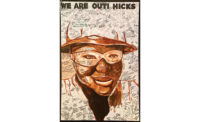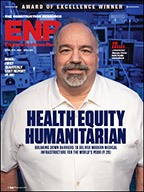Even so, the grassroots success of EWB-USA is generating more buy-in from industry firms, whose leaders either recognize its value or are pushed to do so by active and activist employees. “I just love EWB,” says Ralph Peterson, chairman of CH2M Hill Cos., one of the first firms to strongly support it and accommodate employee activities. “It puts a human face on engineering and reminds us of what we stand for.”
Baker Engineering, Pittsburgh, signed on this month to commit $25,000 a year, thanks to lobbying from project manager Craig Farkos, who started the EWB-USA professional chapter in Washington, D.C., in 2005, and now is president.
CDM, Cambridge, Mass., is committing $60,000 to support employee trips overseas for projects deemed worthy and has created a Web page to link activities of employees involved in 27 chapters across the U.S., says Paul Shea, president of CDM Constructors, who is about to join the EWB-USA board. “We see stronger leadership and a tremendous difference in professional maturity,” he says.
Multitaskers Unite
Julie Gagen, 27, a CDM environmental engineer, credits past and present EWB-USA experiences on a Kenya water-supply project with sharpening her management and coping skills. “I feel comfortable moving at a fast pace, being part of a team and managing five things at once,” she says. “You’re forced to understand what a group is capable of and how people can be effective.” Gagen is co-president of EWB’s northeast region, which includes 72 chapters from Maine to Delaware, and is the Massachusetts state representative.
Gagen says the presence of women volunteers on Third World sites breaks locals’ own cultural stereotypes about women. It also has the same effect back home. “Guys I know in EWB-USA do not have that competitive, masculine personality that is instilled in a lot of young male engineers,” she says. “Women also want to have jobs that are rewarding and challenging and see an impact.” She notes that two engineering-school colleagues, now posted abroad, regret not having EWB experience. But Gagen emphasizes that “it is not just about working overseas. EWB is completely relevant to developing management skill. It is better than a retreat.”

“Kids today don't want to just design a bridge. They want to make a difference.”
—CHRISTIE CHATTERLEY, EDC GRAD STUDENT AT CU AND EWB PROJECT MANAGER
Proponents hope the $5-million Mortenson gift will focus broader attention on the need to create best practices in engineering for developing countries and to share practitioner experience. Robyn Sandekian, assistant director of CU’s EDC program and a graduate-level aerospace engineer, says the gift will fund more graduate students and cover expenses for overseas engineers to study at the university. “Engineers in Nepal are amazing,” she says.
Sandekian credits Amadei’s perseverance. “He has played by the rules, but he stretches them all the time,” she says. “He refuses to believe it cannot be done, and that can be a headache for us.”
Likely the one with the most migraines over the last seven years is EWB-USA Executive Director Cathy A. Leslie, a former Peace Corps and EWB volunteer. She ran the group for years part-time while a civil-engineering manager for Tetra Tech. The ASCE infusion took care of that. Leslie says she “has no clue” how she balanced the two, along with raising two children. But the group’s mission was “energizing,” she says. “I would think about her doing twice as much as me, without a single complaint,” says Michael Paddock, a CH2M Hill program manager in Milwaukee who has mentored local student chapters and led numerous bridge- building project trips in Guatemala.
One Paddock-led effort there by EWB professionals in Wisconsin and students from Milwaukee-based Marquette University now is a finalist for ASCE’s Opal project award: The 67-ft T-beam concrete bridge across the Motagua River in rural Guatemala replaces a 100-year-old foot bridge and will link two Mayan communities. Finished in late 2007, “it is the biggest project we ever did as a group,” says Paddock. Students designed and built the structure as part of their senior design project, mentored by chapter professionals.
Shaping the Vision
Amadei’s vision was shaped early in life as the son of an Italian bricklayer who encouraged him to stay in school “as long as he could stand it.” Born in Roubaix, France, a small town in the industrial north, Amadei’s undergraduate schooling was domestic, but he traveled to Toronto for his civil-engineering master’s degree and to California for a Ph.D. “In grad school, I knew that working in a cubicle was not for me,” he says. The UC faculty position brought Amadei to the Boulder campus. In 1986, he married his wife, Robin, a Denver attorney and mediator.
Amadei’s forays into some of the world’s most remote and strife-torn regions concern Robin, but “I believe God is watching over him,” she says. Daughter Liz Ann is set to join her father on her first EWB-USA overseas venture this summer. The Simmons College junior is pursuing biomedical engineering. Younger brother Alex, about to graduate from high school, is aiming for a career in filmmaking and journalism. She notes that her father sometimes gets “stressed out,” but Amadei points to such diversions as flying rented aircraft and performing as a clown in hospitals and shelters.
For now, Amadei is taking a break from active participation in EWB-USA site trips as he develops the now-enhanced EDC program. He is working with immigration officials to have seven engineering faculty from Kabul Polytechnic University in Afghanistan study at CU next semester. Despite the escalation of hostilities, Amadei will visit the country in May to teach and develop an enterprise to train young people in Kabul to make and sell fuel briquettes made from recycled trash. The business venture, boosted by $72,000 from an anonymous donor, began last year and now employs 72 people, he says.
Amadei plans another trip in June to Palestine, where he will help EWB chapter members from there and Israel build a donated modular house in Bethlehem. Next month, he also is convening the first conference in Cyprus for EWB-International chapters in eastern Mediterranean countries, including Egypt, Jordan, Macedonia and Kosovo, to plan vocational training for young Palestinians on the West Bank and other regional ventures. These projects could include EWB involvement in building sources of water, power and shelter for participants involved in the Abraham’s Path Initiative, a plan to retrace the biblical patriarch’s 400-km journey. A memo of understanding has been signed between EWB and path organizers, says Amadei.
The Mortenson bequest to CU, however, put the kibosh on Amadei’s earlier plans to accept a one-year engineering- school appointment at Princeton University. But he is slowly authoring his third book, tentatively titled “Engineering with Soul,” currently without a publisher. “One objective for the book is to draw a road map for best practices for engineering in the developing world,” Amadei says. “But I still have a lot of writer’s block and too many distractions.” He is returning to the EWB-USA board to assist as the group settles into its new role as a growing professional association.
Wherever Amadei’s future leads, it will not be far from his growing horde of student and young professional engineer disciples who are leading their own charges into a more complex world and relying on his passionate words for inspiration and reassurance.
“That Bernard Amadei was at CU was one of the best things to happen to me in my life,” says Evan Thomas, one of his most accomplished protégés. “I was lucky to have gone to school there. ”





















